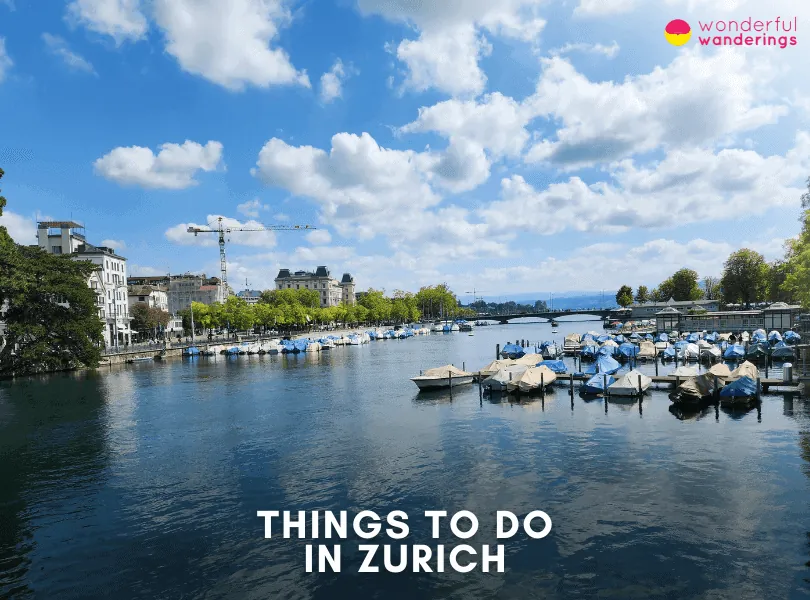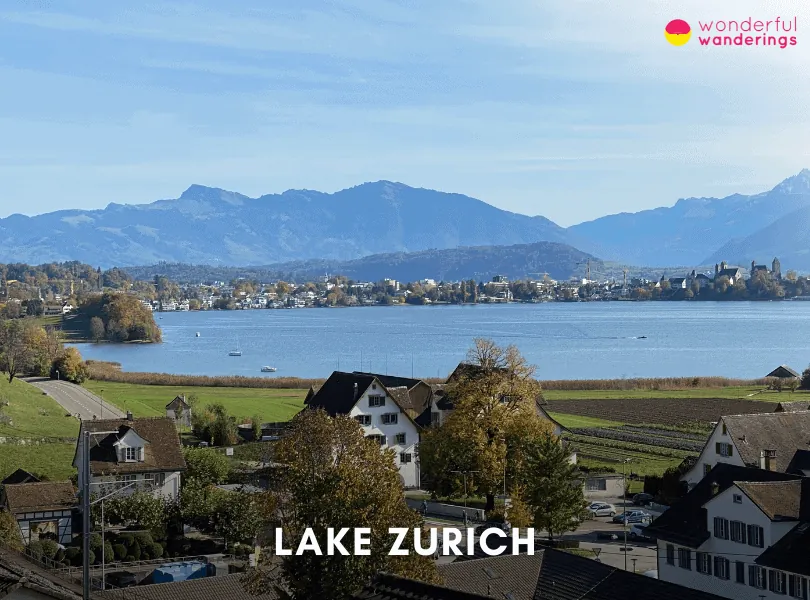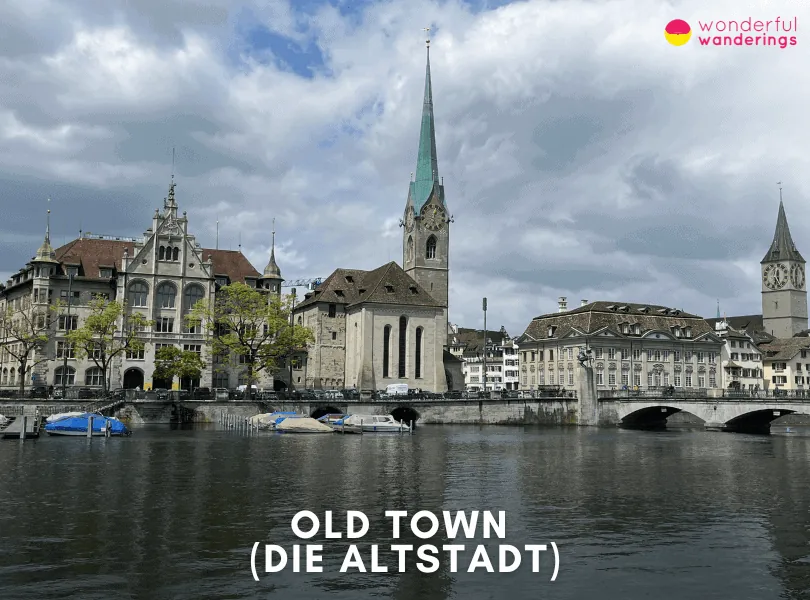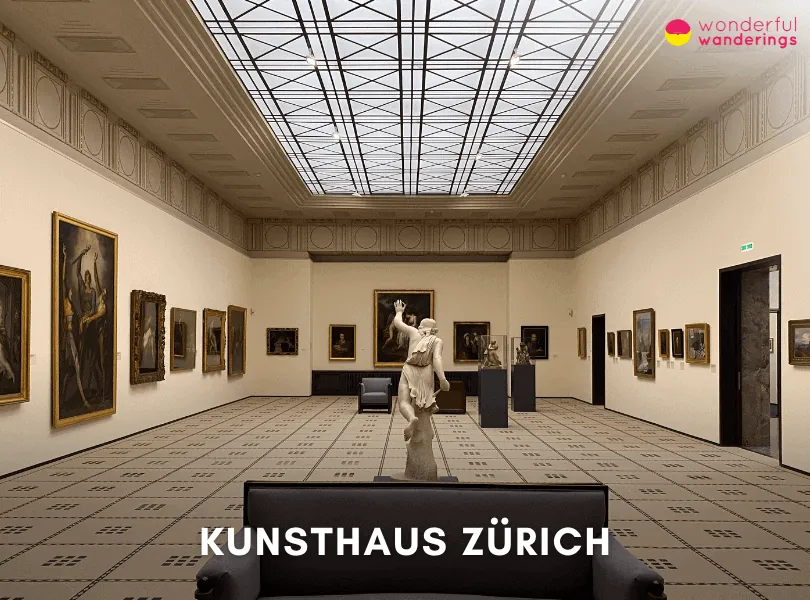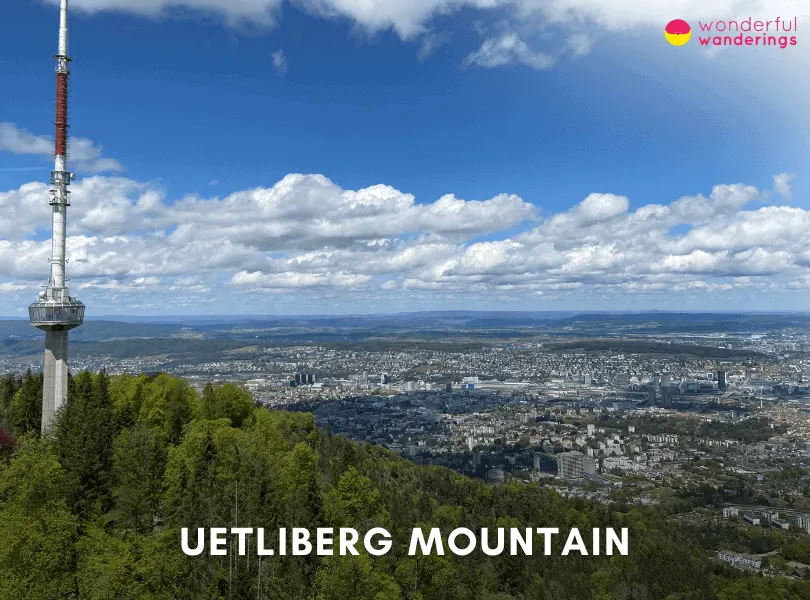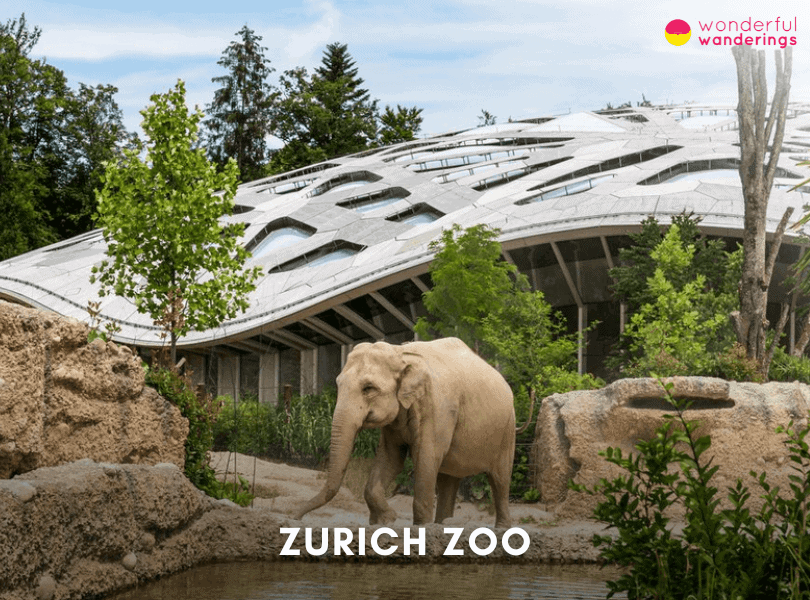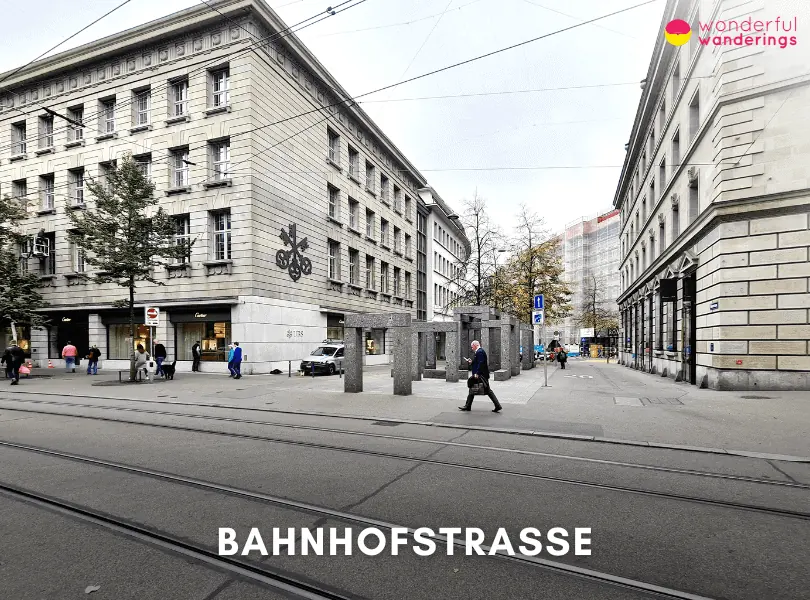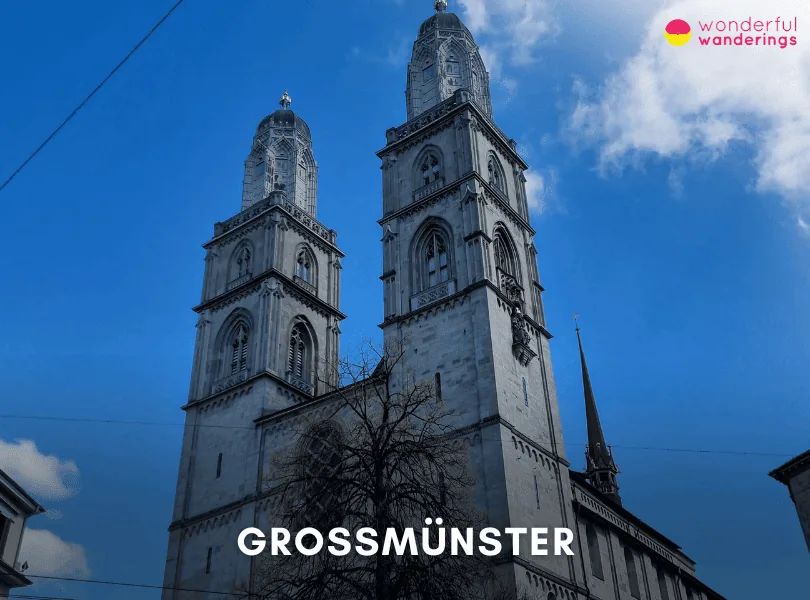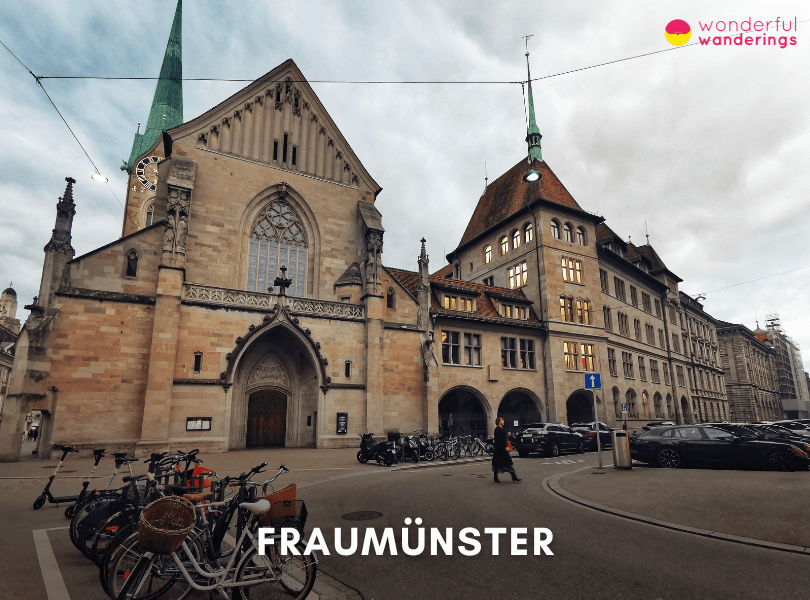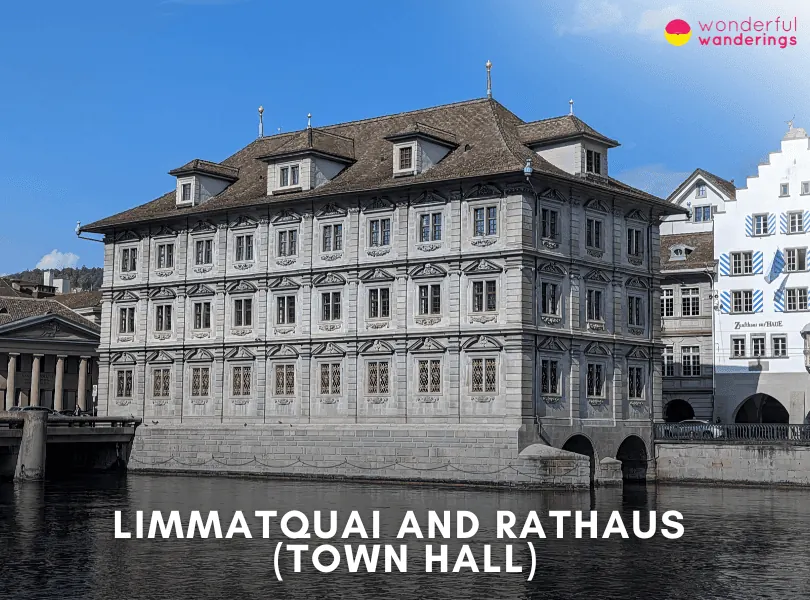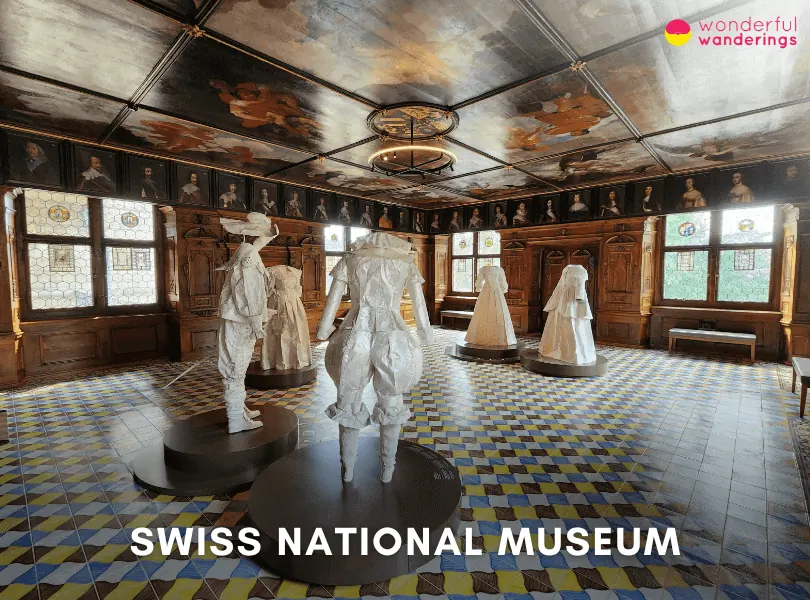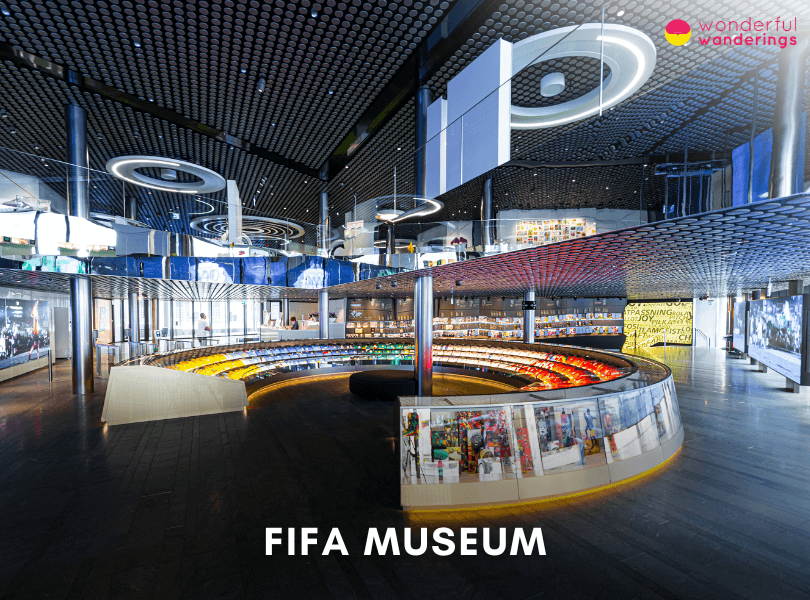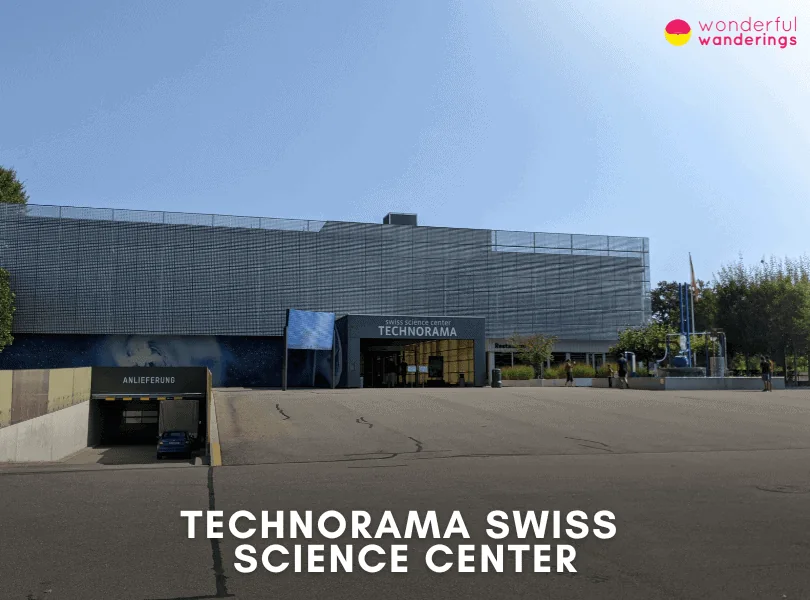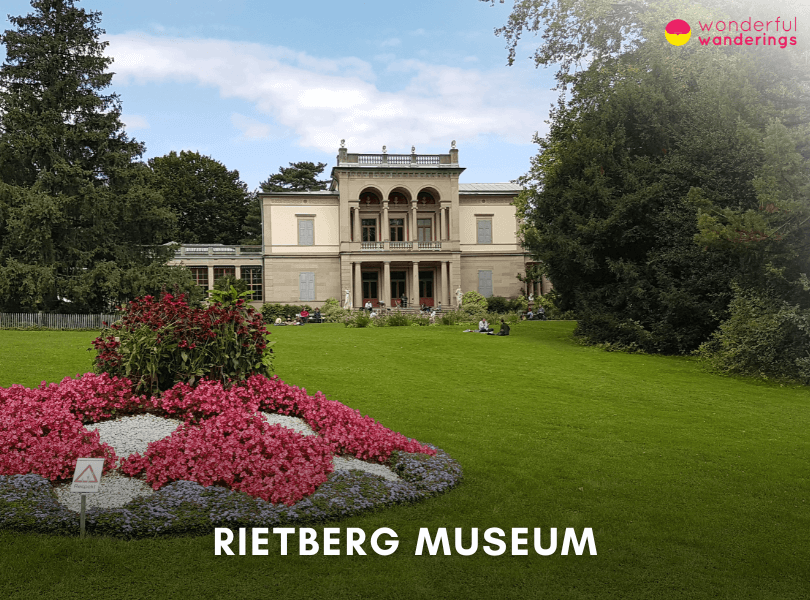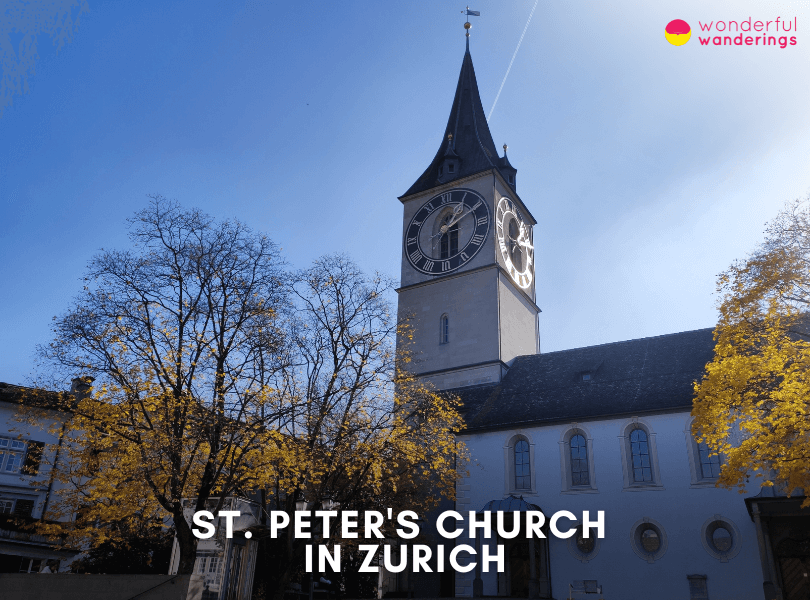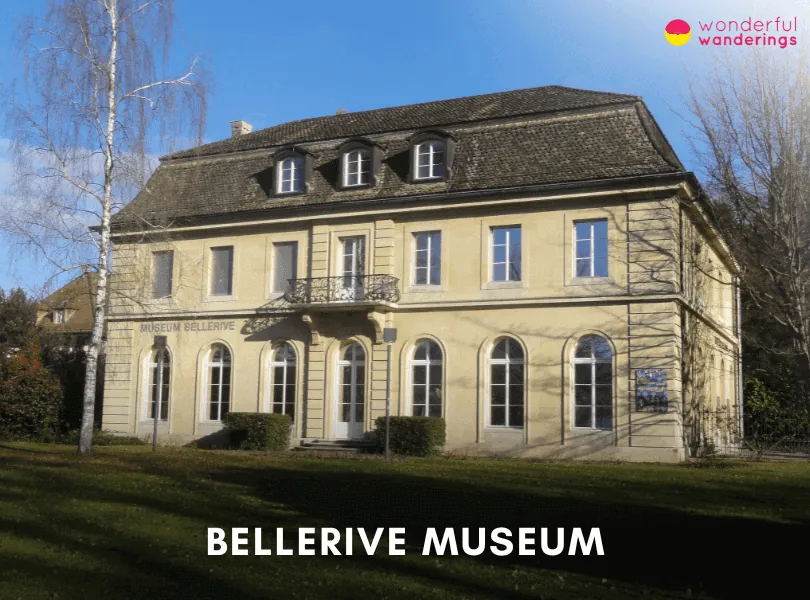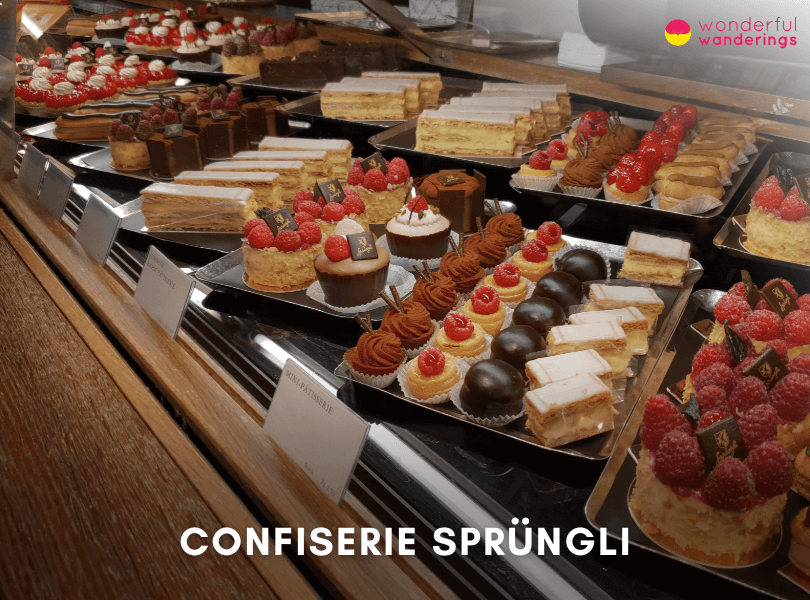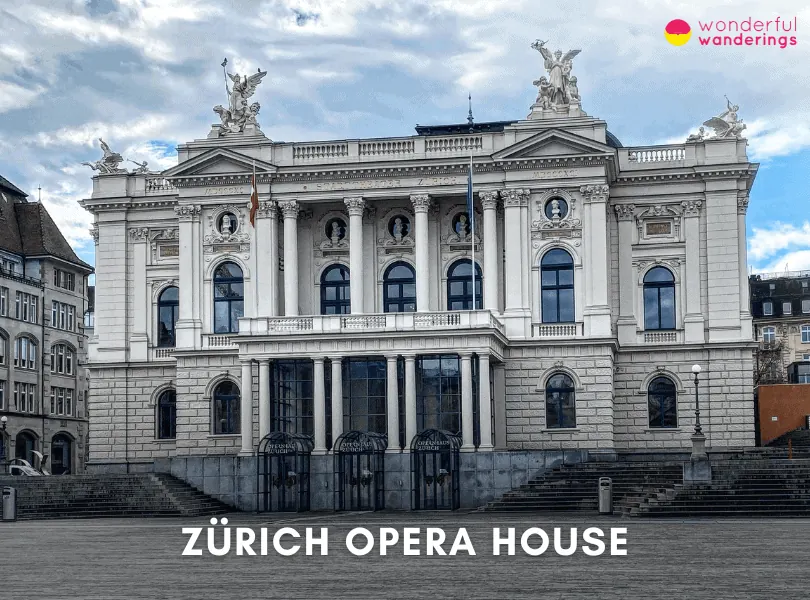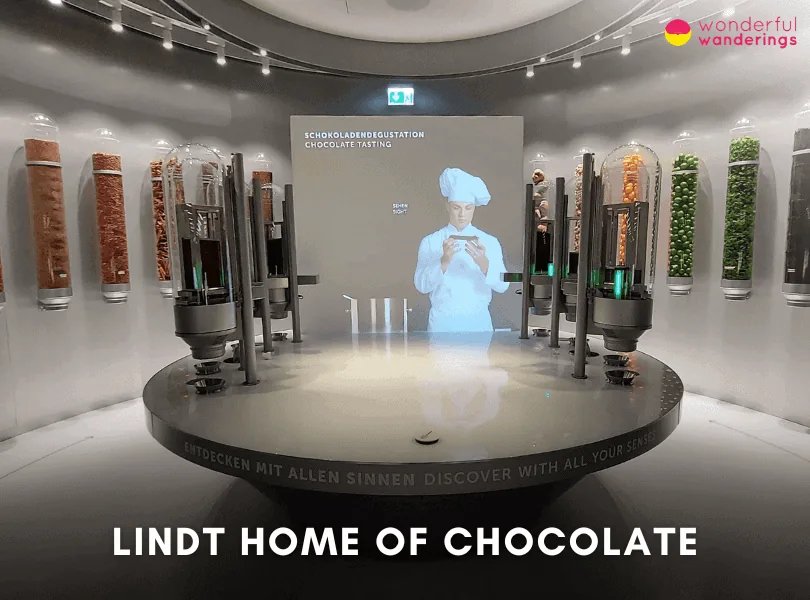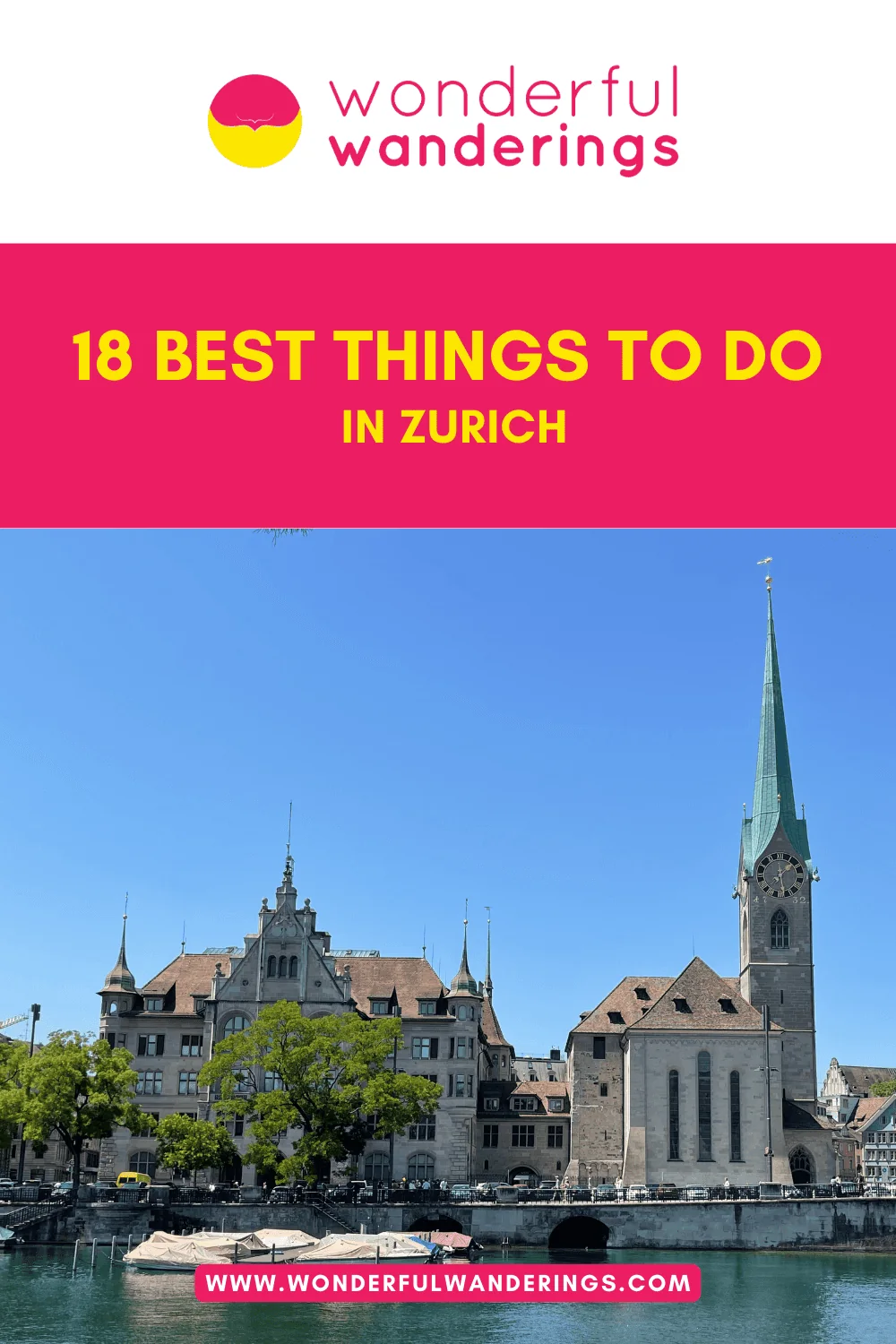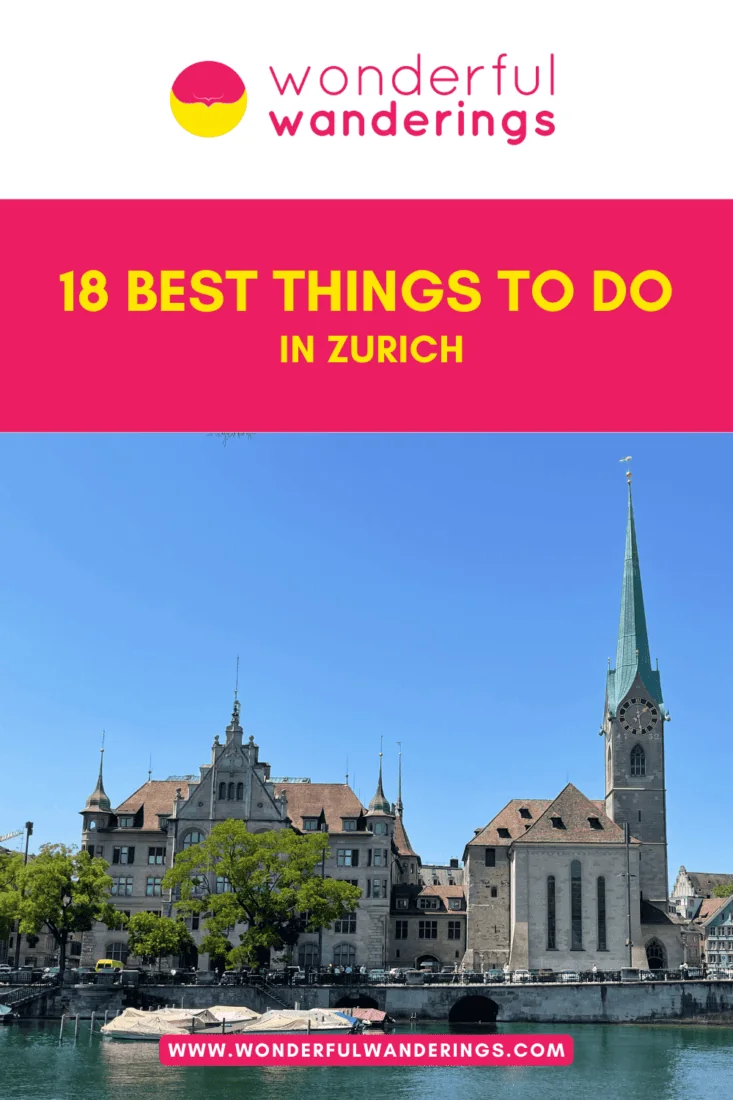Zurich is the largest city in Switzerland and a global center for banking and finance. It is in north-central Switzerland at the northwestern tip of Lake Zurich, between hills to the west and east. Zurich stretches along both sides of the Limmat River, which flows north from Lake Zurich before turning west. The city’s geographic and historic center is a small hill called Lindenhof. Zurich constitutes Switzerland’s primary metropolis, with a total population of 356,467 as of 2023.
There is evidence of a Zurich settlement dating back over 6,400 years when a permanent town was established in the Roman era. The Romans founded it as Turicum, a tax collection point on the Limmat, forming the border between two Roman provinces. Zurich gained independence in 1218 and joined the Swiss Confederacy in 1351. It adopted the Protestant Reformation in 1519 under the leadership of Ulrich Zwingli and later emerged as a leading financial and industrial center in the mid-19th century. The city grew rapidly, absorbing neighboring districts.
Zurich offers a diverse range of attractions and activities that appeal to visitors of all interests. The Old Town (Altstadt) is a must-see, along both banks of the Limmat River. Acclaimed museums such as the Kunsthaus Zürich and Swiss National Museum showcase world-renowned art collections and cultural artifacts spanning centuries, from the dawn of civilization to contemporary masterpieces. Nature lovers will enjoy hiking the extensive woodland trails that ascend Uetliberg Mountain on Zurich’s western outskirts. Popular attractions showcase both the old and the new with sites such as Fraumünster Church or experiencing the cultural exhibits before admiring avant-garde works at the Kunsthaus Zürich art museum. Lake Zurich also offers sailing and swimming in summer and snow-capped Alpine views year-round. Zurich lies in the Central European Time zone, UTC+1 and observes Daylight Saving Time, shifting clocks an hour forward to UTC+2 in summer.
Listed below are the things to do in Zurich.
- Lake Zurich. Lake Zurich is a lake in Switzerland extending southeast of Zurich city. Switzerland’s sixth-largest lake has a surface area of 88 square kilometers. Ancient glaciers formed the lake and have been an important trade and transportation route since the medieval period. Today, it is primarily used for tourism and recreation. Visitors enjoy boat rides, watersports, cycling/walking paths with scenic views, public beaches, lakeside parks, rose gardens, historic landmarks and museums. The lake appeals to all audiences, especially families, couples and nature lovers looking to relax.
- Old Town (Die Altstadt). Zurich’s Old Town forms the city’s historic center and origin, with a history of over 2000 years dating to Roman times. Major landmarks include Fraumünster church, St. Peter’s church, the iconic Quaibridges over the Limmat River, picturesque alleyways and medieval guild houses. Visitors can explore the well-preserved medieval architecture, shop at Bahnhofstrasse, sample Swiss food and culture, meet locals at cafes/bars and view the Limmat River. Attractions appeal to those interested in history, architecture, art, food and culture.
- Kunsthaus Zürich. The Kunsthaus Zürich is the largest art museum in Switzerland, located between Grossmünster church and the university campus. Founded in 1787, it combines a 1910 neo-Renaissance building with a modern 2021 extension. Highlights of its collection include major works by Swiss artists like Alberto Giacometti and Edvard Munch, Impressionists like Monet, Post-Impressionists like Van Gogh, Picasso, Andy Warhol and more. It offers a multifaceted art experience through self-guided/guided tours, special exhibitions, events, amenities and appeals, especially to families, students, tourists and locals.
- Uetliberg Mountain. Uetliberg Mountain is located above Zurich and has impressive panoramic city views. The mountain has offered recreation since the 19th century through hotels, restaurants and observation towers on its summit. Visitors hike, bike, sled, relax at restaurants and view Zurich, Lake Zurich and the Alps from multiple lookout points year-round. Family attractions include the playground at Alpine Wildlife Park and thrill seekers can try paragliding. It appeals to nature lovers, families, couples and those wanting outdoor fun near Zurich.
- Zurich Zoo. The Zurich Zoo covers 27 hectares and is home to over 380 animal species, making it one of Europe’s most species-rich zoos. Major attractions include the Masoala Rainforest, Kaeng Krachan Elephant Park, the Outback exhibit and the large Lewa Savannah. Enclosures mimic natural habitats closely, like the rainforest ecosystem housing lemurs and reptiles. Visitors can observe feedings, training sessions and special shows like the penguin parade. Public events, hands-on animal encounters and four integrated playgrounds make it engaging for visitors of all ages.
- Bahnhofstrasse. Bahnhofstrasse is an exclusive shopping street from Zurich Main Station to Lake Zurich. Lined with luxury stores, boutiques, hotels and restaurants, it is globally renowned as one of the most expensive shopping avenues. Visitors indulge in tax-free shopping, window shop the high-end displays and stroll past historic 19th-century buildings before reaching the lakefront. It appeals especially to those who enjoy fashion, jewelry, luxury goods and fine dining. Its central location also makes it conveniently accessible for tourists and locals.
- Grossmünster. The Grossmünster is one of Zurich’s four major churches, dating back to the 9th century AD. According to legend, Charlemagne founded it where the graves of Zurich’s patron saints were discovered. It played a pivotal role in the Swiss Protestant Reformation in the 16th century. Visitors can explore the architecture and artwork inside and climb the southern tower for panoramic views of Zurich. The church appeals to those interested in history, architecture and Christian heritage, like tourists, students and worshippers.
- Fraumünster. The Fraumünster church has a history tracing back to 853 AD. It is renowned globally for its stained glass windows, including the five boldly colored choir windows by Marc Chagall depicting Biblical scenes and an intricate Gothic window by Augusto Giacometti. Visitors can admire these up close and explore the vaulted hall, crypt, cloister, frescoes and onsite museum. The serene ambiance also appeals to quiet contemplation to audiences like families, couples, solo travelers, architecture enthusiasts and more.
1. Lake Zurich
Lake Zurich (German. Zürichsee) is a lake in Switzerland, extending southeast of Zurich. Switzerland’s sixth-largest lake has a surface area of approximately 88 square kilometers (34 square miles). The history of Lake Zurich dates back thousands of years. The lake basin was formed by ancient glaciers that carved out the landscape, with a terminal moraine creating the lake by damming the area. Lake Zurich has served as an important trade and transportation route. It is still traversed by cargo ships but is primarily used for tourism and recreation. Major towns and cities on the lake’s shores include Zurich, Meilen, Stäfa, Thalwil, Horgen, Wädenswil, Richterswil, Pfäffikon, Rapperswil-Jona and Lachen.
Visitors to Lake Zurich can enjoy a variety of activities. Going for boat rides to explore different towns and islands is very popular. Many companies offer sightseeing cruises and special theme tours focused on food, wine, sunsets, etc. Swimming, sailing, stand-up paddleboarding and other watersports can be done on the lake when weather permits. The lakeside walking and cycling paths provide scenic views for hikers and bikers. There are also public beaches with facilities along the shores. Other attractions include lakeside parks, rose gardens, historic landmarks and museums. The activities at Lake Zurich cater to all audiences but are especially great for families, couples looking for a romantic getaway and nature lovers. The lake and its surrounding towns have a relaxed vibe suitable for people of all ages. Adventurous teens and young adults can try watersports, while seniors may prefer gentle boat tours. Families with kids will find playgrounds, hiking trails and swimming areas to enjoy.
Getting to Lake Zurich is easy from Zurich and other nearby cities thanks to an extensive transportation network. Zurich’s main train station connects to towns along the lake, such as Meilen, Thalwil and Rapperswil-Jona. Boats and ferries also run frequent routes across different sections of the lake. Additionally, the lake can be reached via highways and buses servicing the region. Once at the lake, walking and cycling paths connect various points of interest. There is no admission fee to visit Lake Zurich as it is a public body of water. Museums and gardens around the lake also have their admission prices. Visitors can enjoy Lake Zurich on a budget or opt for premium experiences.
2. Old Town (Die Altstadt)
Zurich’s Old Town (Die Altstadt) is in the city’s heart, along both sides of Limmat. The Old Town forms Zurich’s historic center and origin, with a history dating back over 2000 years to the Roman settlement of Turicum. Major landmarks of Old Town include Fraumünster church with its stunning Chagall windows, St. Peter church featuring the largest church clock face in Europe, the iconic Quaibridges over the Limmat, picturesque alleyways and medieval guild houses.
Zurich’s Old Town features its well-preserved medieval architecture and vibrant modern life. Visitors to the Old Town can explore its past by going inside landmarks like the Grossmünster or St. Peterskirche, strolling the ancient fortified walls and towers and wandering hidden alleyways that reveal surprise courtyards. They can also experience Swiss urban living by shopping at the chic Bahnhofstrasse, sampling cheese fondue at Old Swiss taverns, meeting locals at hip watering holes and watching the river float by from a riverside cafe. The activities in the Old Town appeal to all visitors – especially those who appreciate history, architecture, art, food and culture. Its walkable size and variety of museums, churches, shops, cafes and restaurants offer something for everyone. Families can visit the Swiss Children’s Museum; couples will love romantic dinner cruises on Lake Zurich, while history buffs can book walking tours or take free Altstadt audio guides. Zurich’s excellent public transportation system also makes the Old Town easily accessible.
The best way to reach the Old Town is by taking the train, tram or bus to one of the central stops like Bahnhofstrasse or Bürkliplatz. Zurich’s main train station lies at the north end of the Old Town, providing direct rail links from across Switzerland and Europe. Tram lines 2, 4 and 15 services the district, while various bus routes stop along its perimeter. Once there, all attractions are easily walkable. Entry to simply walk around and experience Zurich’s Old Town is free. Admission fees vary at specific landmarks like Fraumünster, Lindenhof Archaeological Site and the Swiss National Museum.
3. Kunsthaus Zürich
The Kunsthaus Zürich is between the Grossmünster church and the university campus in the heart of Zurich, Switzerland. With a history dating back to 1787, it has grown to become the largest art museum in Switzerland. The Kunsthaus occupies an architectural ensemble spanning four buildings next to Heimplatz at Heimplatz 1, 8001 Zurich. The main building, known as the Moser Building, was constructed in 1910 to a design by architects Karl Moser and Robert Curjel. This original structure combines a neo-Renaissance style with Art Nouveau elements. It has since been expanded multiple times, most recently in 2021 with a major new extension designed by British architect David Chipperfield.
he Kunsthaus Zürich features a collection of over 4,000 paintings and sculptures, including major works by Swiss artists like Alberto Giacometti, alongside an unparalleled ensemble of pieces by Edvard Munch outside his native Norway. Other highlights include extensive representations of Impressionists like Monet, Post-Impressionists like Van Gogh, modern masters like Picasso and contemporary artists like Andy Warhol. Combined with regularly changing special exhibitions, a dynamic event program and onsite amenities, the Kunsthaus offers visitors a multifaceted art experience. Visitors to the Kunsthaus can admire the museum’s paintings and sculptures during self-guided tours or join a guided highlights tour for more insight. Special exhibitions expand on collection works or introduce new themes and artists.
The Kunsthaus appeals to a wide audience. Its variety ensures families, school groups, students, seniors, tourists and locals will all find inspiration. The recent Chipperfield extension also helps the museum serve large crowds flexibly. And opportunities for relaxation and learning make it an engaging, multi-generational experience.
The Kunsthaus is conveniently located in Zurich’s city center. Trams and buses also stop directly outside. The museum is fully wheelchair accessible, with lifts connecting all levels. Admission ranges from free Wednesdays to 23 CHF (€21, $26, £24) for an adult ticket. Special rates apply to seniors, students, children and groups.
4. Uetliberg Mountain
Uetliberg Mountain is on the Swiss plateau above Zurich, Switzerland. With an elevation of 2,850 feet (870 meters) above sea level, it offers impressive panoramic views of Zurich, Lake Zurich and the Alps. The history of Uetliberg dates back to the Celtic era over 2,000 years ago, when it was likely used as a hill fortification. In the 19th century, hotels, restaurants and observation towers were built on the summit to cater to visitors. Uetliberg still serves locals and tourists as a recreational spot for hiking, biking, sledding, picnicking and sightseeing.
Uetliberg Mountain features a variety of outdoor activities and its proximity to Zurich’s city center offers them. Its hiking trails convert into popular sledding runs ranging from 1 to 3 kilometers, serviced by a dedicated toboggan lift. Hiking and mountain biking routes traverse scenic Alpine meadows and forests during summer. The Planet Trail from Uetliberg to Felsenegg makes for a fascinating hike through a scale solar system model. The panoramic views of Zurich, the lake and the mountains are stunning all year round. Visitors to Uetliberg can hike, bike, sled, relax at restaurants and take in the breathtaking vistas from multiple lookout points. Family-friendly attractions include the playground by the train station and Alpine Wildlife Park. Thrill-seekers can also try paragliding. With its variety and ease of access, Uetliberg appeals to nature lovers, families, couples, seniors and anyone wanting outdoor fun near Zurich.
Reaching Uetliberg is convenient via the Uetliberg train (line S10) from Zurich Main Station, taking 20 minutes to Uetliberg station. Driving is restricted, but parking is available at the mountain’s base. Various bus connections also service Uetliberg and neighboring trailheads. Entry to Uetliberg’s hiking trails and most park areas is free. Specific activities like mountain carts, the toboggan run and paragliding have individual pricing. Enjoying Uetliberg’s natural scenery and outdoor offerings can be very budget-friendly.
5. Zurich Zoo
The Zurich Zoo, known as Zürich Zoologischer Garten, is in the Fountain Quarter on the lower slopes of the Zürichberg in Zurich, Switzerland. With a history dating back to 1929, it covers 27 hectares and is home to over 380 animal species, making it one of Europe’s most species-rich zoos. Major attractions at the zoo include the Masoala Rainforest Hall, Kaeng Krachan Elephant Park, the Outback exhibit and the large Lewa Savannah area.
Zurich Zoo focuses on keeping animals in enclosures resembling their natural habitats as closely as possible. The Masoala Rainforest features a vast indoor ecosystem housing lemurs, chameleons, reptiles and tropical birds in a space mimicking their native environment in Madagascar. The Kaeng Krachan Elephant Park provides over 11,000 square meters of outdoor space for elephants to roam and swim. The zoo’s latest exhibit, the Outback, allows visitors to observe kangaroos, emus, koalas and other Australian species up close in a recreation of their wilderness. Visitors to the Zurich Zoo can observe feeding times, animal training sessions and special shows like the popular penguin parade. Walking tours provide background on the zoo’s history and conservation efforts. Those wanting more hands-on experience can attend public events like Zoo Nights or book special animal encounters. There are also four playgrounds integrated throughout for kids. Zurich Zoo makes an engaging outing for visitors of all ages. Its scenic location and relaxing green spaces also appeal to couples and seniors. Enthusiasts interested in zoology, conservation and learning about different ecosystems can appreciate specialized exhibits like the Masoala Rainforest.
Reaching the Zurich Zoo is convenient via public transportation from Zurich Main Station or the airport. Simply take tram line 5 or 6 directly to the zoo. It can be accessed from Zurichbergstrasse by car; parking is available onsite. Entry fees are 27 CHF (€28, $31, £24). Special discounted rates apply on certain weekdays.
6. Bahnhofstrasse
Bahnhofstrasse is in the heart of Zurich, Switzerland. It is a 1.4 kilometers (0.86 miles) long street running from Bahnhofplatz by Zurich Main Station to Bürkliplatz on Lake Zurich. As the name suggests (“Bahnhof” meaning train station), it was built after Zurich’s Main Railway Station was constructed.
Bahnhofstrasse has a world-famous reputation globally as one of the most exclusive and expensive shopping avenues. Lined with luxury flagship stores, glamorous boutiques, banks, hotels and restaurants, it embodies the pinnacle of Swiss shopping. Leading global brands sit alongside prestigious Swiss watches and jewelry retailers. Its aesthetic 19th-century architecture also lends old-world charm. Visitors can indulge in tax-free shopping at Bahnhofstrasse’s many high-end stores, with items ranging from designer fashion to watches costing hundreds of thousands of dollars. Window shopping to admire the chic displays is also popular. Strolling the full length of the street leads past historic buildings before culminating at the lakefront, offering a glimpse of Zurich’s past and present. The shops attract all types of visitors but especially appeal to those who enjoy fashion, jewelry and luxury goods. Foodies also appreciate the international dining options. Its central location makes it convenient for tourists and locals alike to access.
Reaching Bahnhofstrasse is easy via Zurich’s extensive public transportation network. Trains, trams and buses service stops along or near the street. On foot, it is 300 meters from Zurich HB station. Entry to simply walk and window shop along Bahnhofstrasse is free. There are also shops and restaurants suiting most budgets. Visitors can soak up the elegant ambiance without spending at all.
7. Grossmünster
The Grossmünster is in the old town of Zurich, Switzerland, between the Limmat River and the Zürichberg hill. It is one of the four major churches of Zurich, with a history dating back to the 9th century AD. According to legend, Charlemagne founded the Grossmünster, where the graves of Zurich’s patron saints Felix and Regula were discovered. Construction of the present church began around 1100 AD in the Romanesque architectural style. The address is Grossmünsterplatz, 8001 Zürich.
Grossmünster has immense historical and architectural significance. As one of Zurich’s most recognizable landmarks, its twin towers are the most visible feature of the city’s skyline. The church also played a pivotal role in the Protestant Reformation in Switzerland, serving as the home church of prominent reformers like Huldrych Zwingli and Heinrich Bullinger in the 16th century. Visitors can explore the architecture and artworks inside Grossmünster, including the Romanesque crypt, Gothic choir and modern stained glass windows. The onsite museum in the cloister highlights church artifacts and the history of the Reformation. Visitors can also climb the southern tower, known as the Karlsturm, for beautiful panoramic views of Zurich. The church appeals to those interested in history, architecture and Christian heritage, including tourists, students, families and worshippers. Its location in the heart of Zurich also makes it easily accessible for locals. English-language guided tours are available for groups.
Reaching the Grossmünster is convenient via public transportation from anywhere in Zurich. It sits just south of the main train station adjacent to tram stops. Additionally, the church is only a short walk from hotels and attractions in the historic district of Zurich. Entry to the Grossmünster is free, with open access to the nave and grounds. Guided tours start from 150 CHF (€158, $174, £137) per group. Visitors have ample opportunities to experience Grossmünster at no cost.
8. Fraumünster
The Fraumünster church is in the old town of Zurich, Switzerland, on the west bank of the Limmat River opposite the Grossmünster cathedral. The church traces its history back to 853 AD when it was founded by King Louis the German. The Fraumünster was built on the site of a former abbey for aristocratic women run by his daughters. Fraumünster is important in Zurich’s history and its world-famous stained glass windows by 20th-century artists Marc Chagall and Augusto Giacometti. The five choir windows by Chagall in signature bold colors depicting Biblical scenes are the main highlight for many visitors. The earlier Giacometti window in the north transept crafted in a Gothic style also impresses with its intricate beauty.
Visitors to the Fraumünster can admire these stained glass masterpieces up close and explore the rest of the church, including the high vaulted hall, Romanesque crypt downstairs and cloister with frescoes relating to the church’s medieval founding legend. The onsite museum and gift shop provide more insight and mementos. The church interior, featuring Protestant decor, creates a calm, meditative atmosphere for quiet contemplation. The Fraumünster’s artworks and serene ambiance appeal to visitors of all backgrounds, including families, couples, solo travelers and seniors. History and architecture enthusiasts will appreciate the church’s long story showcased by the crypt, frescoes and ornate stonework.
Reaching the Fraumünster is easy via Zurich’s efficient tram, bus and train networks. The church sits just across the river from the main train station. Once there, all attractions are accessible within the church. Opening hours run daily from 10 am to 6 pm during summer and 10 am to 5 pm in winter. Admission costs 5 CHF (€5, $5, £3) for adults, including an audio guide in multiple languages.
9. Limmatquai and Rathaus (Town Hall)
Limmatquai is a street running along the eastern bank of the Limmat River in the heart of Zurich’s historic Old Town (Altstadt). It follows the river for 1 kilometer (0.62 miles), lined with upscale shops, restaurants and historic guild halls. At the north end lies the Rathaus (Town Hall), a prominent Renaissance building built over the Limmat atop arched supports. The history of Limmatquai dates back to the 19th century when the current riverside promenade was built, replacing old medieval buildings that previously fronted the river.
Limmatquai features a blend of natural scenery and Swiss culture. The river flows swiftly as boats glide across its blue waters, with the Swiss Alps visible in the distance. Historic guildhalls like the 17th century Zunfthaus zur Meisen and 18th century Haus Zum Rüden now house trendy cafes, offering a glimpse into Zurich’s mercantile past. The street is also popular for upscale shopping and people-watching. The Rathaus (Town Hall) is an iconic landmark at the north end showcasing ornate Renaissance architecture. Its Baroque hall features an intricately carved ceiling and oil paintings depicting Zurich’s political history. Visitors can observe the municipal council in session on Wednesday evenings from the public balcony. The adjacent Wasserkirche church is also a draw.
Strolling Limmatquai’s length makes for a relaxing promenade, passing cafes, swans on the river and bobbing boats. Shopping, dining and photographing historic architecture are popular activities. Various river cruise boats also stop along the quay. The atmosphere appeals to tourists and locals alike, including families, couples, photographers and culture enthusiasts drawn to the blend of natural and manmade beauty.
Reaching Limmatquai is easy via Zurich’s efficient tram and bus system. Various stops service the street along its length. On foot, it is 300 meters from the Zurich HB train station adjacent to the Bahnhofstrasse shopping area. Once there, the sights are very walkable. Entry to the promenade is free, while specific attractions like the Town Hall tower and church museums separate fees.
10. Swiss National Museum
The Swiss National Museum (German. Landesmuseum) is at Museumstrasse 2 in Zurich, Switzerland. The history traces back to 1898, in the heart of Zurich between Zurich Main Station and Platzspitz Park. The museum building was constructed in a neo-Gothic style by Gustav Gull, resembling a fairytale castle. Its striking architecture, featuring towers, turrets, courtyards and archways, has made it one of Zurich’s most iconic landmarks. The museum’s founding ties into a late 19th-century movement to preserve Swiss heritage and crafts. Its diverse collections and exhibitions aim to provide insight into Swiss identity and national history from prehistoric times to the present day.
The Swiss National Museum assembles over 830,000 objects spanning Swiss cultural history and the arts. The permanent exhibitions “Archaeology Switzerland,” “History Switzerland,” and “The Collection” showcases handicrafts, paintings, everyday objects, armaments, religious artifacts and more. The breadth and depth of its holdings make it the largest museum of cultural history in Switzerland. Special exhibitions also periodically highlight specific themes or artists. Visitors can explore the various collection galleries and historical exhibition rooms to glimpse Switzerland’s rich past. Guided tours provide added context and stories behind notable pieces. Temporary shows present unique perspectives. The onsite restaurant “Spitz” offers traditional Swiss cuisine, while the museum shop sells books and souvenirs. Events like concerts and expert talks also occur regularly. The museum welcomes families, couples, domestic and international visitors, history enthusiasts, researchers and anyone wanting to learn about Swiss heritage. Interactive stations help engage children.
Zurich’s efficient public transportation network makes reaching the Swiss National Museum easy. Trains, trams and buses from the airport or any city location stop just outside the museum entrance. Additionally, Zurich Main Station is 300 meters away on foot. Various parking garages are also nearby. The central location near the main train station makes it conveniently accessible. Entry fees to the permanent exhibitions are 10 CHF (€10, $11, £9). Guided tours come at an additional charge per group. Access to the museum shop, cafe and courtyard is free.
11. FIFA Museum
The FIFA Museum is in Zurich, Switzerland, at Seestrasse 27 in the Enge quarter, across from the Zurich Enge train station. The museum occupies the renovated Haus zur Enge building, showcasing international football’s culture, history and heritage and the Fédération Internationale de Football Association (FIFA). The FIFA Museum is special houses the world’s largest FIFA World Cup memorabilia collection under one roof. The museum’s extensive exhibits include match balls, trophies, uniforms, videos, artwork and more, spanning every tournament edition. Interactive displays let visitors test their commentating and refereeing skills. The building, designed by Tilla Theus, impressively integrates historical elements like wood beams into an ultra-modern glass facade.
Visitors can explore several floors and zones focused on World Cup history. The Museum also spotlights legendary players and teams, the evolution of equipment and game rules, international fan culture and personal stories demonstrating football’s global impact. Special rotating exhibitions, a museum shop, a cafe, a kids’ play area and an on-site library round out the offerings. The FIFA Museum welcomes football fans and culture enthusiasts alike. Football lovers of all ages are sure to enjoy the interactive games, video highlights and seeing rare artifacts up close. The museum’s family-friendly vibe also suits tourists, school groups and those wanting to learn what fuels the world’s most popular sport.
Reaching the FIFA Museum is convenient via Zurich’s extensive transit network. The museum is directly across from Zurich Enge train station, just three stops from Zurich HB main station. Trams 5, 6 and 13 also stop steps away. Limited parking is available at the nearby Hafen Enge garage. Once there, all attractions are easily walkable. Entry fees to access the main museum exhibition are 27 CHF (€28, $31, £24). Discounted rates apply Tuesday through Friday. Special guided tours and events may incur additional charges. The museum shop, cafe and sports bar are freely accessible.
12. Technorama Swiss Science Center
Technorama Swiss Science Center is at Technoramastrasse 1, 8404 Winterthur, Switzerland. It is the northeastern part of Winterthur, a train ride away from the center of Zurich. The history dates back to 1947, when an association was formed to establish a technical museum in the Winterthur-Zurich-Baden region. Technorama opened its doors to the public in 1982 as Switzerland’s first interactive science center. Inspired by similar hands-on science museums in San Francisco and other parts of Europe, it has pioneered a playful, inquiry-based approach to science education in Switzerland. After undergoing gradual reconstructions over the past decades, Technorama spans over 6,500 square meters with indoor and outdoor areas.
Technorama features interactive exhibits, allowing visitors to explore natural phenomena and technology first-hand. With over 500 experiment stations spread across themed sections like “Mechanics”, “Water”, “Light & Sight”, and “Mathematics”, there are countless levers to pull, objects to manipulate, reactions to trigger and concepts to grasp. Seven specialized labs also offer physics, chemistry and biology workshops. This hands-on setup gives it an unparalleled capacity for science learning through self-directed play and discovery.
Visitors to Technorama can independently wander through the exhibit halls, trying out different stations or joining scheduled demonstrations and performances like the crowd-pleasing high-voltage theater. Older children can take part in age-appropriate workshops at the labs, while younger kids enjoy playgrounds integrated throughout. Special exhibitions and events also run periodically. The onsite restaurant, picnic area and green spaces provide opportunities to refuel and relax. Technorama appeals to children and families, student groups, tourists and science enthusiasts of all ages. Offering STEM learning through entertainment engages visitors even with little prior science background. The recent addition of outdoor experiment stations has further expanded its offerings.
Reaching Technorama is straightforward via Zurich’s extensive public transit network. Direct trains run frequently from Zurich Main Station to Oberwinterthur Station, from where bus number 5 stops at Technorama’s entrance. It can be accessed by car from the highway exit Oberwinterthur and has ample free parking. Standard admission fees are CHF 33 (€34, $38, £30). There are discounted rates for students, seniors, groups and special circumstances. Access to most outdoor areas is included with regular tickets. Specific labs, workshops and events may require additional fees. Annual membership passes are also available for individuals or families.
13. Rietberg Museum
The Rietberg Museum is at Gablerstrasse 15 in the Rieterpark area of central Zurich, Switzerland. The museum occupies a 17-acre park on the western shore of Lake Zurich, housing a collection of art from Asia, Africa, Oceania and the Americas. Rietberg Museum has an exclusive focus on showcasing non-European art and cultures. It contains over 21,000 artifacts spanning sculptures, paintings, textiles, photographs and more from diverse societies worldwide and the only one of its kind in Switzerland.
The museum complex comprises four historic villas, including the Wesendonck Villa, where composer Richard Wagner once lived and a striking underground expansion designed by architects Krischanitz and Grazioli in 2007. Visitors to the Rietberg can explore several galleries displaying the museum’s permanent collection and special exhibitions that change 2-3 times yearly. Highlights include Buddhist art from Tibet, Chinese ceramics and paintings, Indian miniature paintings and wooden masks and statues from Africa and Oceania. The Rietberg Museum attracts art enthusiasts, culture lovers, families, tourists and anyone seeking a glimpse into non-Western artistic heritage. Varied public programming, including concerts, lectures and hands-on art workshops, also target diverse audiences.
Reaching the museum is convenient via Zurich’s extensive public transit networks. Tram number 7 and bus 33 stop directly at the Rietberg Museum. The museum can be accessed by car from Zurichbergstrasse. Entry to the permanent collection costs 16 CHF (€16, $18, £14) for adults, while Visitors up to age 16 enter free. Special rates for families, seniors, students and groups are also available. Access to the museum complex, park, shop and cafe is free.
14. St. Peter’s Church in Zurich
St. Peter’s Church is in the old town of Zurich, Switzerland, between the Limmat River and the Lindenhof hill. With a history dating back to the 9th century AD, it is one of the four major churches of Zurich. Charlemagne founded St. Peter’s on the site where the graves of Zurich’s patron saints, Felix and Regula, were discovered. Construction of the present church began around 1100 AD in the Romanesque architectural style.
The St. Peter’s has immense historical and architectural significance. As one of Zurich’s most recognizable landmarks, its twin towers are the most visible feature of the city’s skyline. The church also played a pivotal role in the Protestant Reformation in Switzerland, serving as the home church of prominent reformers like Huldrych Zwingli and Heinrich Bullinger in the 16th century. Visitors can explore the architecture and artworks inside St. Peter’s, including the Romanesque crypt, Gothic choir and modern stained glass windows. The onsite museum in the cloister highlights church artifacts and the history of the Reformation. Visitors can also climb the southern tower, known as the Karlsturm, for beautiful panoramic views of Zurich. The church appeals to those interested in history, architecture and Christian heritage, including tourists, students, families and worshippers. Its location in the heart of Zurich also makes it easily accessible for locals. English-language guided tours are available for groups.
Reaching St. Peter’s is convenient via public transportation from anywhere in Zurich. It sits south of the main train station adjacent to tram stops. The church is only a short walk from hotels and attractions in the historic district of Zurich. Entry to St. Peter’s is free, with open access to the nave and grounds. Access to certain areas like the crypt, tower and museum are fees. Visitors have ample opportunities to experience this landmark church at no cost.
15. Bellerive Museum
The Bellerive Museum is located in the Seefeld district of Zurich, Switzerland, along Lake Zurich’s shore at Höschgasse 3, 8008 Zurich. The museum occupies an elegant lakeside villa once the home of silk manufacturer Julius Bloch. Bellerive Museum features an extensive collection of applied arts focused on Art Nouveau creations but spanning over a century of design history. Highlights include glassware, ceramics, furniture, textiles, posters and puppets. Particularly strong areas feature Wiener Werkstätte and Jugendstil works, lacquer art from East Asia, English Aestheticism designs by William Morris and Swiss applied arts after 1900, including pieces by prominent decorative artists. The museum also holds a significant collection of musical instruments.
Visitors to the Bellerive Museum can explore the diverse galleries showcasing permanent collection items and rotating exhibitions related to art, craftsmanship and design. Guided tours provide added insight, while the gift shop offers exhibition catalogs and design objects. The scenic lakeside café is also a draw. Special programs like concerts and expert talks occur periodically as well. The Bellerive Museum welcomes visitors of all backgrounds. The interplay between art, functionality and history on display intrigues adults, while children can appreciate the colors and textures. Temporary shows on fashion, photography, architecture, etc., also target diverse audiences.
Reaching the Bellerive Museum relies on Zurich’s efficient public transit system. Trams 2 and 4 and buses 33 and 72 stop near the museum entrance. By car, it can be accessed from Seefeldquai Road along the lake. Pedestrian walking paths also connect it to downtown. Entry to the permanent collection gallery is 10 CHF (€10, $11, £9) with discounted rates for students, seniors, etc. Access to the museum shop, courtyard and lakeside café is free. Various combination tickets and annual membership options are also available.
16. Confiserie Sprüngli
Confiserie Sprüngli is at Bahnhofstrasse 21 in Zurich, Switzerland. It was founded in 1836 by David Sprüngli, a luxury chocolate and confectionery manufacturer and retailer in Zurich. The history of Confiserie Sprüngli dates back to 1836 when David Sprüngli acquired a small confectionery shop on Zurich’s Marktgasse owned by Johann Heinrich Vogel. He started producing chocolates named “David Sprüngli & Sohn” in 1845. David Sprüngli opened the company’s now famous café and shop on Paradeplatz, which remains the headquarters today. In 1892, the chocolate production branch split into a separate company now known as Lindt & Sprüngli. The original confectionery business continued under David Sprüngli’s son, David Robert and later generations of the Sprüngli family.
Confiserie Sprüngli focuses on the artisanal production of high-end chocolate confections and pastries made from the finest ingredients. Signature products include the Luxemburgerli macaron, truffles, pralines, chocolate bars and hot chocolate. With over 2,000 products across categories like chocolate, ice cream, cakes and sandwiches, Sprüngli has become renowned for Swiss indulgence and quality. Visitors to Confiserie Sprüngli can sample freshly made chocolate creations at the café on Paradeplatz or purchase packaged items at retail shops in Zurich and Switzerland. The flagship Zurich store on Paradeplatz also houses a restaurant and bar. Specialty products like the iconic Luxemburgerli macarons are prepared by hand daily. Sprüngli ships many items worldwide for those wanting to enjoy its delicacies at home. Confiserie Sprüngli welcomes visitors of all ages and interests. Its elegant settings, delectable flavors and accessibility within Zurich make it a convenient spot to experience refined Swiss cuisine and culture.
Reaching Confiserie Sprüngli is easy using Zurich’s extensive public transit network. The headquarters on Paradeplatz is within walking distance from Zurich HB main station. Trams, buses and S-Bahn train services stop around the city center near other Sprüngli locations. Visitors can also access Sprüngli shops at the airport and major train stations. Items for purchase vary in price; visitors can freely stroll through stores and admire window displays. Entry to the Paradeplatz café and restaurant comes with the cost of food and drinks consumed.
17. Zürich Opera House
The Zürich Opera House (German. Opernhaus Zürich) is at Falkenstrasse 1 in the heart of Zurich, Switzerland. The opera house has established itself as one of the leading opera houses in Europe. The neo-Baroque style opera house was constructed based on designs by architect brothers Gustav and Eduard Gull. Its lavish interior boasts a grand staircase, red velvet seats, intricate stucco and crystal chandeliers. The main auditorium has 1,100 seats. Several renovations and extensions over the decades have enhanced the facilities. Today, the opera house complex spans an entire city block.
The Zürich Opera House is renowned for showcasing innovative productions and assembling exceptional casts. As the home stage of the Zürich Opera, Ballet Zürich and the Philharmonia Zürich orchestra, it presents over 300 performances across opera, ballet, concerts and more per season. World-famous singers, conductors and directors regularly feature in the program. The opera house also runs its own Opera Studio for emerging artists as part of a commitment to nurturing rising talent. Visitors can attend performances from the rich seasonal calendar spanning well-known operas, bold contemporary works, sparkling ballets and diverse concerts. Those wanting a behind-the-scenes glimpse can join guided backstage tours. The elegant onsite restaurant and bars offer opportunities to mingle with a cocktail or meal. The box office also sells gift cards and merchandise. The Zürich Opera House enthralls seasoned aficionados and first-time visitors alike. Its ambiance, central location and classic and innovative programming mix make it popular with tourists and locals. Special rates for students and discounted day-of tickets help attract younger crowds on tighter budgets.
Reaching the opera house using Zurich’s highly efficient public transit system is easy. It is within walking distance from multiple train, tram and bus stops, including Stadelhofen station. Various regional trains and airport links provide direct connections to Zurich, from where the opera house is a few stops away. Entry prices vary across different seating categories and seasonal productions. Special rates apply for subscriptions, students, seniors groups and same-day sales.
18. Lindt Home of Chocolate
The Lindt Home of Chocolate is at Schokoladenplatz 1 in Kilchberg, Switzerland, along Lake Zurich near Zurich. With a history dating back to the founding of the Lindt chocolate factory in Kilchberg in 1899, the interactive chocolate museum opened in 2020 next to Lindt & Sprüngli’s longstanding headquarters and production facilities. The museum was designed by renowned Swiss architects Christ & Gantenbein to integrate seamlessly with the surrounding historic brick Lindt buildings. Its modern glass and steel facade houses over 1,500 square meters of exhibition space across multiple floors. Key highlights are the world’s largest Lindt chocolate shop, covering over 500 square meters and a spectacular 30-foot-high chocolate fountain.
The Lindt Home of Chocolate provides an interactive, multimedia chocolate tour experience. Visitors can explore chocolate’s history, from its origins to present-day production, through seven differently-themed rooms. Visitors can journey to a Ghanaian cocoa plantation, meet pioneering Swiss chocolatiers, sample Lindt delicacies and see the manufacturing process first-hand. The combination of sights, sounds, smells and tastes brings the world of chocolate to life. Visitors can attend chocolate-making workshops in the onsite Lindt Chocolateria, shop for sweet treats, dine at the café and explore the research lab. The flexible spaces also host events. Designed for visitors of all ages, playground zones are integrated for families with kids.
Reaching the Lindt Home of Chocolate is convenient from Zurich’s city center or the airport via train, bus, boat or car. Public transportation options include taking the S8/S24 train to Kilchberg or the 165 electric bus, dropping off right at the museum entrance. Entry fees to access the chocolate tour exhibition are 15 CHF (€15, $17, £13). Kids under seven enter for free. Special group and family rates apply. Guided tours, chocolate-making courses and events incur additional charges. The shop, café and fountain areas are freely accessible.
What are the best museums to visit in Zurich?
Listed below are the best museums to visit in Zurich.
- The Swiss National Museum. The museum at Museumstrasse 2 in central Zurich is Switzerland’s most frequently visited cultural history museum. Housed in a striking complex featuring medieval castle architecture blended with a modern wing, the museum’s permanent exhibitions showcase Swiss history, archaeology, arts and crafts from prehistoric times to the present day. Temporary exhibits highlight specific periods of Swiss history and culture. The Swiss National Museum is best for visitors interested in immersing themselves in Switzerland’s rich cultural heritage.
- The Kunsthaus Zürich. The Kunsthaus Zürich is the city’s major art museum and is renowned for its extensive collections of artwork from the Middle Ages to contemporary pieces. Highlights include iconic works by renowned artists such as Monet, Picasso and Giacometti. In addition to world-class permanent collections, the museum hosts temporary exhibitions focused on various art-related themes and movements. Kunsthaus Zürich is best suited for art aficionados, especially those interested in Impressionist, Modern and Swiss art. Admission varies by exhibition, with free entry on Wednesdays and discounts with the Zurich Card.
- The Museum Rietberg. The Museum Rietberg is Switzerland’s sole art museum dedicated to non-European art, showcasing pieces from Asia, Africa, the Americas and Oceania. The artwork is housed in a striking complex comprised of three 19th-century villas and a contemporary emerald glass extension set amidst the lush Rieterpark. Spanning different eras, the museum’s collection includes ethnographic works from past cultures and cutting-edge examples of contemporary world art. It is best for visitors interested in non-Western art and cultures.
- FIFA World Football Museum. The museum is dedicated to the history of international football. Located near FIFA headquarters, the museum features over 1,000 exhibits related to the origins and evolution of football and past World Cup tournaments. Highlights include historical memorabilia and an interactive zone with simulations and games allowing visitors to test their football skills. The FIFA Museum offers engaging exhibits for football fans and families with kids.
- The Zurich Tram Museum. The Zurich Tram Museum is in a former tram depot and documents Zurich’s extensive tram history. Historic trams dating from 1897 to modern models, ticket machines and a mini train are on display. Hands-on activities like climbing aboard vintage trams and an indoor play area make this museum popular for families. It appeals to visitors interested in Zurich’s history and development.
What are the best things to do in Zurich with kids?
Listed below are the best things to do in Zurich with kids.
- Zurich Zoo. The Zurich Zoo sprawls across 35 acres of forested hillside, home to over 4,000 animals representing 380 species in enclosures mimicking diverse habitats. As Switzerland’s most popular attraction, kids can get up close to exotic wildlife like elephants, giraffes and monkeys, enjoy pony rides and petting zoos or burn energy across playgrounds tailored for all ages scattered throughout the park.
- Technorama Swiss Science Center. Technorama Science Museum in Zurich features over 500 interactive exhibits across zones like the Explorium, Media World and Swiss Arena. Children aged 4-14 can produce TV shows, build earthquake-proof towers, race bobsleds and explore optical illusions while playfully engaging with science and technology. It also has Switzerland’s largest IMAX 3D cinema onsite.
- Lindt Home of Chocolate. The Lindt Home of Chocolate Museum in Zurich offers interactive glimpses into Switzerland’s famed chocolate history and production through aromatic rides and factory viewing galleries. Highlights for kids include the world’s largest 9-meter Lindt chocolate fountain, chocolate-making workshops and samples of freshly made pralines. Tailored for sweet tooths aged five and up.
- Swiss Children’s Museum. The Swiss Children’s Museum at Seefeldstrasse 59 allows children to role-play adult jobs like postal workers, bank clerks or bakers within imaginative environments. Children can dress in costumes, climb giant structures, perform lab experiments or get creative in the crafts studio. As Zurich’s only museum fully promoting learning through play, it makes for an ideal rainy-day activity.
What are the best activities for a business traveler in Zurich?
Listed below are the best activities for a business traveler in Zurich.
- Old Town Walking Tour. The Old Town features cobbled lanes and medieval architecture along the banks of the Limmat River, dotted with cafes, shops, guildhalls, fountains and historic town squares. Business travelers can take a self-guided walk to appreciate landmarks like the Fraumünster church with its renowned Marc Chagall stained glass windows, St. Peter’s Church and its colossal clock face, the largest in Europe. It is the perfect activity for business travelers to stretch their legs between meetings and gain insight into Zurich’s long history and culture.
- Swiss Chocolate Workshop. The Lindt Home of Chocolate holds indulgent chocolate workshops, allowing business visitors to get hands-on in making their own Lindt truffles and praline creations under the guidance of expert chocolatiers. It’s a fun, interactive way to spark creativity and unwind with world-famous Swiss chocolate after meetings.
- FIFA World Football Museum. The FIFA World Football Museum holds interactive games and simulations alongside exhibits documenting football history and star players. Test your skills with football-themed challenges or learn about legendary tournaments, players and memorabilia through the 1,000+ displays. It offers a unique, engaging experience after meetings for football fans of all ages.
- Lake Zurich Cruise. The Lake Zurich boat tours offer scenic rides with impressive views of the Swiss Alps glistening in the distance. Frequent 1 to 2-hour roundtrip cruises run to destinations like Rapperswil, allowing business travelers to relax on the water and see Zurich from a unique vantage point between meetings. It is an ideal activity to soak up the natural scenery, take photographs and escape the bustling city while enjoying the view of the lake.
- Swiss National Museum. The Swiss National Museum building spans Swiss cultural history with permanent and temporary exhibits. Wander through archaeological relics, traditional handicrafts and artifacts conveying daily life from ancient to modern times. It is an interesting option for business travelers to gain insight into Swiss heritage between meetings.
Where is Zurich?
Zurich is located in north-central Switzerland at the northwestern tip of Lake Zurich. It sits 30 kilometers (18 miles) north of the Swiss Alps, between hills on the west and east sides. To the west lies the Albis mountain range, home to the 2,850-foot Uetliberg mountain. To the northeast sits a range of hills marking the divide between the Limmat and Glatt valleys. Zürich stretches along both sides of the Limmat River, which flows north from Lake Zürich before turning west. Zurich’s geographic and historic center is a small hill called Lindenhof on the west bank of the Limmat. ürich includes districts beyond its natural confines, extending into the Glattal valley to the northeast and the Limmattal valley to the north. The boundaries of medieval Zurich are still easily recognizable by the Schanzengraben canal.
What is the history of Zurich?
Zürich has evidence of settlement dating back over 6,400 years; a permanent town was established in the Roman era. The Romans founded Turicum as a tax collection point on the Limmat River, which formed the border between two Roman provinces. Zürich gained independence in 1218 and joined the Swiss Confederacy in 1351. It adopted the Protestant Reformation in 1519 under the leadership of Ulrich Zwingli. Zürich became an industrialized financial center in the mid-19th century to improved infrastructure like railways and banking secrecy laws. It grew rapidly, absorbing neighboring districts. Due to Swiss neutrality, Zürich was a refugee hub during both World Wars. Zürich focused on sustainable urban development, public transit, environmental protection and preserving green spaces while remaining Switzerland’s economic capital.
What language is spoken in Zurich?
The main language spoken in Zurich is Swiss German, specifically the Zürich German dialect (Züritüütsch). The official language used in government education and business is Swiss Standard German, but about 70% of Zurich’s population speaks Zürich German daily. This local dialect is one of several in German-speaking Switzerland, all with roots in medieval German.
What time zone is Zurich in?
Zurich is in the Central European Time zone, UTC/GMT +1 hour. It observes Daylight Saving Time in the summer, moving clocks forward by 1 hour to UTC/GMT +2, called Central European Summer Time (CEST). Depending on Daylight Saving Time, it switches between being UTC+1 in the winter (CET) and UTC+2 in the summer (CEST). The time zone abbreviation when DST is not active is CET.
How many people live in Zurich?
The population of Zurich is 356,467 as of 2023. Specifically, there are a total of 177,085 men and 179,382 women living in the city. The median age of Zurich residents is 43 years old.
Regarding age breakdown, there are 18,208 babies under four years old, with 8,885 girls and 9,323 boys. The city also has 18,139 children between 5 and 9 years old, including 8,851 girls and 9,287 boys. For children aged 10-14 years old, there are 17,315, with 8,884 boys and 8,430 girls. Zurich has 17,260 teenagers between 14 and 19 years, 8,805 boys and 8,455 girls.
What are the most interesting facts about Zurich?
Listed below are the most interesting facts about Zurich.
- Language. The main language spoken in Zurich is Swiss German, specifically the Zürich German dialect (Züritüütsch). The official language used in government education and business is Swiss Standard German and 70% of Zurich’s population speaks Zürich German daily.
- Currency. The currency used in Zurich and all of Switzerland is the Swiss Franc (CHF). Banknotes come in denominations of 10, 20, 50, 100, 200 and 1,000 francs. Coins are issued in 5, 10, 20, 50 centimes and 1, 2 and 5 francs. Switzerland is not part of the European Union and has retained its currency rather than adopting the Euro.
- Timezone. Zurich is one hour ahead of Coordinated Universal Time (UTC+1) in the Central European Time Zone. It observes Daylight Saving Time with clocks moving forward one hour to UTC+2 in summer, from late March through late October. The exact dates of DST changes vary per year.
- Power plugs. Switzerland uses 230-volt electricity with Type J power outlets accepting plugs with three round pins in a triangular shape. Type C Europlugs with two round pins also work. Travelers from the Americas, UK or Asia will need a plug adapter to charge devices.
How many days are needed to see Zurich?
Spending two to three days to see the top sights and experience Zurich is recommended. Visitors can explore the Old Town, see the iconic Grossmünster church, stroll along the scenic lakeside promenade, tour top museums like the Swiss National Museum and ride to the top of Uetliberg mountain for panoramic views. The number of days allows for more sightseeing, trips to places like Lucerne or Mount Rigi, enjoying Zurich’s lively cafe culture and shopping for Swiss watches, chocolate and other souvenirs. Zurich’s compact city center and efficient public transportation enable visitors to experience many highlights in a busy two to three-day itinerary.
Is Zurich worth visiting?
Yes, Zurich is worth visiting. Zurich offers world-class museums, galleries, shopping, dining, nightlife and Alpine views. Key attractions include the picturesque Altstadt (Old Town) along the Limmat River, Fraumünster church with Marc Chagall windows, Kunsthaus art museum, Swiss National Museum and the lively Niederdorf district. Zurich is also a hub for finance and counts Albert Einstein, James Joyce and Vladimir Lenin among famous former residents. Beyond the city, visitors can easily access the Swiss Alps, Swiss towns and the shores of Lake Zurich. Zurich manages to blend urban sophistication with old-world Alpine charm.
Is Zurich expensive to visit?
Yes, Zurich is expensive to visit. Zurich is considered an expensive city compared to other European destinations. Zurich is Switzerland’s “wealthiest and most expensive city” as the economic and financial capital. As one of the world’s major financial centers, Zurich attracts business travelers and hosts numerous conferences, likely driving up hotel prices. Switzerland is an expensive country to visit due to high wages, taxes and quality standards. Zurich is expensive even by Swiss standards as the country’s economic engine.
Is Zurich safe to visit?
Yes, Zurich is very safe to visit. It consistently ranks among the world’s top ten major cities on safety indexes. Violent crime rates are extremely low and incidents involving tourists are rare. The Old Town and most tourist areas are well-lit and have a visible police presence. As in any big city, travelers should take normal precautions. staying alert in crowds, keeping valuables secure, avoiding poorly lit areas at night and taking care at train stations. Violent crime is rare enough that Zurich residents feel comfortable walking alone, even late at night. Zurich invests heavily in advanced police forces and security technology to prevent crimes and maintain its reputation for safety and stability. Visitors should feel very safe exploring Zurich’s charming streets and waterfront promenades.
Is Zurich easy to visit with kids?
Yes, Zurich is easy to visit with kids. Its extensive transit system makes getting around stress-free and kids love the boats, funiculars, trains, trams and buses. Top attractions like the Swiss National Museum, Chocolate Adventure Museum, toy museums and Zurich Zoo have interactive exhibits that fascinate children. Lake Zurich offers boat rides and swimming areas perfect for families. The city is extremely safe and clean, with plenty of pedestrian zones for strolling. Swiss punctuality makes schedule planning simple. Zurich’s Alpine setting provides a fairytale backdrop. Swiss fondness for dairy means kids’ menus always have chocolate, cheese or yogurt. Zurich does have some steep hills that make stroller use challenging, but baby carriers work well. Many restaurants and cafes provide highchairs and play areas.
What is Zurich famous for?
Zurich is famous for several things. Firstly, Zurich is most famous for banking, finance, precision watches and clocks, chocolate and art. Secondly, Zurich is home to two of the world’s largest banks, UBS and Credit Suisse and is a global hub for banking and finance. Swiss-made watches, especially luxury brands like Rolex and Patek Philippe, are globally prized for their precision, reliability and status. Thirdly, Zurich’s chocolate shops produce Alpine-inspired confections. Lastly, Zurich has an impressive art scene, with world-class museums like the Kunsthaus and cutting-edge galleries. The Dada art movement began in Zurich. Zurich has an intellectual legacy. Albert Einstein taught at the Swiss Federal Institute of Technology, James Joyce wrote Ulysses here and Vladimir Lenin plotted the Russian Revolution from his Zurich exile.
Who are the most important people born in Zurich?
Listed below are the most important people born in Zurich.
- Max Frisch (1911-1991). Max Frisch was a playwright and novelist born May 15, 1911 in Zurich. He became one of German language theater’s most influential literary figures following World War II. His best-known works included “The Firebugs”, “Andorra”, and the novel “I’m Not Stiller”, all of which explored themes of personal identity, morality and Switzerland’s political history. He died on April 4, 1991 in Zurich.
What to eat in Zurich?
Listed below are what you can eat in Zurich.
- Swiss Fondue. Restaurants in Zurich offer the iconic melted cheese dip eaten by spearing bread with long forks. Cheese and meat fondue feature items cooked tableside in bubbling pots of oil or broth. Swiss Fondue is one of the best food to eat in Switzerland.
- Zürcher Geschnetzeltes. Zürcher Geschnetzeltes is a popular veal dish in Zurich consisting of thin strips of veal sautéed with mushrooms in a creamy white wine sauce, often served atop Rösti potatoes. The flavorful dish originated in Zurich and remains a staple in local restaurants nationwide.
- Raclette. Raclette is melted cheese served in Zurich restaurants and raclette stalls, where the cheese is melted tableside and scraped over plates of small boiled potatoes, pickles, onions and dried meat. The Swiss dish is perfect for a cold winter day.
- Rösti. Rösti are traditional large potato pancakes made by grating potatoes and frying them into patties, often served in Zurich topped with sausages, bacon, cheese or fried eggs. Rösti makes a typical Swiss farmer’s breakfast or dinner.
- Chocolates. Zurich has a reputation for fine chocolates. The city has many chocolate shops and cafes offering fresh truffles, pralines, bars, cakes and more for visitors to sample. Lindt, Sprüngli and Teuscher are popular local high-end brands.
- Bratwurst. Bratwurst and other sausages are beloved in Zurich, including veal sausages often served with Rösti potato cakes or fresh salads featuring local produce. Sausage carts can be found year-round at markets and events.
- Älplermagronen. Älplermagronen are elbow macaroni baked with potatoes, cheese, cream and onions, is a typical Alpine comfort food found on many Zurich restaurant menus. The hearty, cheesy baked pasta dish is perfect after a day outdoors.
What are the best places to eat in Zurich?
Listed below are the best places to eat in Zurich.
- Kronenhalle. Kronenhalle is an elegant fine dining restaurant located on Rämistrasse near the Bellevueplatz tram stop in Zurich. The wood-paneled interior showcases an impressive collection of original artwork by famous artists such as Chagall, Matisse and Picasso. Kronenhalle serves high-quality traditional Swiss cuisine, focusing on meat and seafood dishes prepared in a refined European style. Reservations are essential for dinner at this refined and cultured dining destination.
- Haus Hiltl. Haus Hiltl on Sihlstrasse, Zurich, is known to be the oldest vegetarian restaurant in the world, serving meatless cuisine since 1898. This large, bustling eatery offers an extensive buffet with a global variety of salads, hot vegetarian dishes and desserts from which diners can choose. Haus Hiltl also has an à la carte vegetarian menu, a bar, outdoor garden seating and even a small grocery shop, making it a versatile spot for casual vegetarian fare.
- Volkshaus. The historic Volkshaus near Stauffacher station houses a theater, restaurant and bar under one roof. The stately dining room preserves 1920s elegance with upholstered booths, dramatic lighting and white tablecloths. Volkshaus serves updated versions of Swiss classics like rösti, schnitzel and sausage, emphasizing locally sourced ingredients. The bar and Biergarten provide more casual, affordable dining and drinking options in Zurich.
- Maison Manesse. Maison Manesse in Zurich holds a Michelin star for its refined plant-based tasting menus. Diners can choose between the 6- or 9-course “Maison Experience” to sample the creative, elegant cuisine. Dishes feature artful, unexpected ingredients like wild garlic oil and pork intestine in delicate presentations. The sleekly minimalist dining room provides an intimate, welcoming setting for this unique fine dining experience. It is also one of the best restaurants to eat in Zurich.
- Frau Gerolds Garten. Frau Gerolds Garten in Zurich West is a modern, lively garden restaurant filled with shipping containers converted into food stalls, bars and shops. This urban oasis comes alive on sunny days when its outdoor benches fill up with hip locals enjoying beers, cocktails and casual international fare like burgers, barbecues, pasta and salads. When cold, seating moves indoors to the heated winter garden and charming chalets for a cozy, festive atmosphere.
What are the best areas to stay in Zurich?
Listed below are the best areas to stay in Zurich.
- Die Altstadt (Old Town). This medieval neighborhood is right in the heart of Zurich, close to top attractions like Grossmünster Church, Fraumünster Church, Lindenhof Hill, Bahnhofstrasse shopping street and the Limmat River. With its cobblestone lanes and historic architecture, Altstadt offers a quintessentially Swiss experience. It is convenient and safe for solo travelers as it is the most central and pedestrian-friendly area.
- City Center. The City Center neighborhood puts visitors steps away from sights like the Swiss National Museum, Zurich Town Hall and St. Peter’s Church. This well-connected transit hub also provides easy access to Zurich. The neighborhood is busy and touristy but generally safe.
- Seefeld. The upscale Seefeld neighborhood has lakeside parks, promenades and views across the water. It is a short tram ride from attractions in the bustling city center. Seefeld offers a refined atmosphere perfect for travelers seeking proximity to nature alongside culture.
- Zurich West. Zurich West has become a trendy, creative hub filled with shops, cafes and nightlife. This neighborhood provides an exciting base to experience Zurich’s arts scene. Zurich West has rougher edges than other areas, but its gritty-chic vibe remains intriguing. Zurich West is also ideal for solo travelers and families.
- Enge. Enge lies south of the city center, hugging the western lakeshore. Its scenic waterfront parks connect visitors to the natural beauty surrounding Zurich. Museums, high-end shops and Lake Zurich activities also beckon in this refined neighborhood. Enge offers a convenient home base from the bustle yet still in the city center.
What are the best accommodations to stay in Zurich?
Listed below are the best accommodations to stay in Zurich.
- Baur au Lac. Baur au Lac is a luxurious 5-star hotel set in its private park on the shore of Lake Zurich, offering lavish and elegant rooms with scenic views of the lake and distant Alps. Amenities at this refined hotel include two fine dining restaurants, a wine boutique and cellar, a top-floor fitness center, a beauty salon and spa and a convenient central location near top attractions like Bahnhofstrasse and the Old Town. Baur au Lac provides the ultimate luxurious experience in Zurich with amenities and service befitting its 5-star rating.
- Hotel Adler. Hotel Adler is a well-preserved 16th-century building in the heart of Zurich’s charming Old Town, offering a unique traditional decor with wood beams and painted murals. Its restaurant, Swiss Chuchi, serves classic Swiss specialties like cheese fondue and rösti in an intimate, wood-paneled dining room. Hotel Adler provides a convenient, mid-range Old Town accommodation option rich in historic character. Hotel Adler is also known as one of the best hotels to stay in Zurich.
- Friendly Hostel. Friendly Hostel offers affordable dorms and private rooms in a modern, four-story building just five minutes from Paradeplatz and the main train station. This centrally-located hostel includes free WiFi, a communal kitchen, a library, a backyard, 24-hour reception and friendly, helpful staff to assist guests. Friendly Hostel’s perfect central location, budget prices and clean, modern facilities make it a top choice for backpackers and budget travelers.
- Neues Schloss Privat Hotel. Neues Schloss Privat Hotel is a small, exclusive 5-star boutique hotel in Zurich’s scenic Enge district, providing lavish rooms full of luxury amenities and highly personalized, attentive service. Set in a carefully restored historic building near Lake Zurich, this refined hotel offers amenities like a gourmet restaurant, wine tastings, spa treatments and family activities. Neues Schloss Privat Hotel’s tranquil location, luxury details and family offerings create an upscale retreat.
- 25hours Hotel Langstrasse. 25hours Hotel Langstrasse in Zurich’s Kreis 4 district provides funky, colorful, contemporary rooms with unique décor and high-end facilities like rainfall showers. On-site amenities include a Swiss cuisine restaurant, a lively bar, a fitness room and a relaxing sauna. 25hours Hotel Langstrasse places guests steps from cafés, galleries and nightclubs.
How to get from Zurich to Zurich Airport?
There are a few ways to get to Zurich Airport from Zurich. These are by train, tram, taxi and rental car. Firstly, take the frequent train services from Zurich HB (main station) to the airport. The journey takes 10-15 minutes and trains run daily from 5 am to midnight. The train station is right under the airport, easily accessible by escalators/elevators and is free with a Swiss Travel Pass. Secondly, take the tram line 10 that connects Zurich’s city center to the airport. The total journey is 35 minutes as the tram makes multiple stops. Trams run every 8-15 minutes from 5 am to midnight. It is also free with a Swiss Travel Pass. Thirdly, taxis are available 24/7 in Zurich and at the taxi ranks at the airport. The journey takes 15-20 minutes non-stop and allows door-to-door service. Lastly, rental car offices are available at the airport from companies like Sixt, Hertz and Europcar. Rental cars offer flexibility for road trips/sightseeing. The fastest and most convenient way to get from Zurich to the airport is by train.
How to get from Zurich to Bern?
There are a few ways to get to Bern from Zurich. These are by train, bus and driving. Firstly, take a direct train from Zurich main station (Zurich HB) to Bern. The journey takes 56-88 minutes, depending on the type of train. The fastest trains are the Intercity (IC) trains, which take 56 minutes. Ninety daily trains run on this route and are operated by Swiss Railways (SBB). Sample train times. Depart Zurich HB at 12.06 and arrive Bern at 13.24 (1h 18min); Depart Zurich HB at 13.02 and Arrive Bern at 13.58 (56min). Secondly, take a direct bus from Zurich to Bern Car Terminal Neufeld. The journey time is 2 hours and 15 minutes. Buses run once daily and are operated by companies like Union Ivkoni, FlixBus and RegioJet. Lastly, driving from Zurich to Bern, with a distance of 123 kilometers (76 miles), takes 1 hour and 20 minutes in normal traffic. The fastest and most convenient way is to take a direct train from Zurich main station (Zurich HB) to Bern.
Where to go shopping in Zurich?
There are several great places to go shopping in Zurich. These are Bahnhofstrasse, Niederdorf, Zurich West, Seefeld and Glattzentrum. Firstly, Bahnhofstrasse features numerous luxury boutiques from top international brands like Louis Vuitton, Prada and Rolex and Swiss brands like Bally. It connects the main train station to Lake Zurich. Secondly, Niederdorf is a pedestrian zone in Zurich’s Old Town, which has a mix of arts and crafts shops, bookstores, souvenir shops, restaurants, bars and pubs. It also transforms into a nightlife hub in the evenings. Thirdly, Zurich West has become a trendy shopping, dining and nightlife hub. Key attractions include the Viadukt arches with quirky boutiques and the flagship store of Freitag, which sells bags made from old truck tarps. Fourthly, Seefeld is an upscale neighborhood near the Opera House that offers high-end boutiques and concept stores selling curated fashion, design objects and lifestyle products. Its annual Christmas market is also popular. Lastly, Glattzentrum is one of Switzerland’s largest malls with over 90 international brands, shops, restaurants and events like book festivals.
What festivals or events are taking place in Zurich?
Listed below are the festivals or events that are taking place in Zurich.
- Zurich Pride Festival (June). The Zurich Pride Festival celebrating LGBTQ diversity takes place annually in mid-June, centered around the vibrant Christopher Street Day parade through the city. Over the 2-day festival, thousands participate in the parade and attend speeches, concerts, workshops and exhibitions promoting equal rights. The festival transforms the Kasernenareal area into a hub of music, art, food and a proud celebration of identity.
- Street Parade (August). Street Parade is one of the world’s biggest electronic and dance music festivals, attracting almost a million revelers along Lake Zurich. On the 2nd Saturday of August, DJs and dancers parade down the streets on extravagant floats as crowds dance to techno beats. The parade promotes themes like love, peace, freedom and tolerance and continues well into the night with parties around the city.
- Zurich Fest (every three years). Zurich Fest is a huge public festival that takes place over three days once every three years. Blending a folk festival, carnival and music event, Zurich Fest features hundreds of performances, village fetes, parades, food stalls, children’s activities, art displays and lakeside events across the city. The next Zurich Fest will likely occur in 2025, bringing up to 2 million visitors to Zurich’s streets and parks. It is also one of the much-awaited festivals in Zurich.
- Knabenschiessen (September). Knabenschiessen is a traditional marksmen competition for 13 to 17-year-olds. Over a week in September, over 3000 teenage sharpshooters in Zurich compete as the city hosts Switzerland’s largest shooting festival with a funfair atmosphere. The tradition features parades, brass bands, alphorn players and festive food.
PIN FOR LATER
Find below our best guides about Switzerland.

